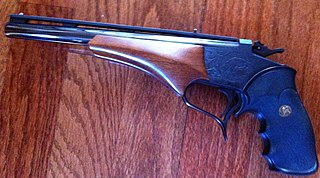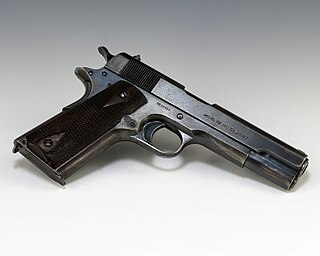
A revolver is a repeating handgun that has at least one barrel and uses a revolving cylinder containing multiple chambers for firing. Because most revolver models hold up to six cartridges, before needing to be reloaded, revolvers are commonly called six shooters.

A derringer is a small handgun that is neither a revolver, semi-automatic pistol, nor machine pistol. It is not to be confused with mini-revolvers or pocket pistols, although some later derringers were manufactured with the pepperbox configuration. The modern derringer is often multi barreled, and is generally the smallest usable handgun of any given caliber and barrel length due to the lack of a moving action, which takes up more space behind the barrel. It is frequently used by women because it is easily concealable in a purse or a stocking.

A semi-automatic pistol is a handgun that automatically ejects and loads cartridges in its chamber after every shot fired. Only one round of ammunition is fired each time the trigger is pulled, as the pistol's fire control group disconnects the trigger mechanism from the firing pin/striker until the trigger has been released and reset.

The pepper-box revolver or simply pepperbox is a multiple-barrel firearm, mostly in the form of a handgun, that has three or more gun barrels in a revolving mechanism. Each barrel holds a single shot, and the shooter can manually rotate the whole barrel assembly to sequentially index each barrel into alignment with the lock or hammer, similar to rotation of a revolver's cylinder.

The Desert Eagle is a gas-operated, semi-automatic pistol known for chambering the .50 Action Express, the largest centerfire cartridge of any magazine-fed, self-loading pistol.

An automatic revolver also known as semi-automatic revolver, is a revolver that uses the recoil energy of firing for cocking the hammer and revolving the cylinder, rather than using manual operations to perform these actions. As semi-automatic firearms, the shooter must manually operate the trigger to discharge each shot.

In American English, a pocket pistol is any small, pocket-sized semi-automatic pistol, and is suitable for concealed carry in a pocket or similar space.

The Steyr M is a series of semi-automatic pistols developed by Steyr Mannlicher GmbH & Co KG of Austria for police services and the civilian shooting market. Design work on the new pistol began in the early 1990s and the final product known as the M9 was officially unveiled in the spring of 1999. The M40 version chambered in .40 S&W was developed before the M9, followed later by the M357 and two smaller variants of the M9 and M40 designated the S9 and S40 respectively. These pistols were developed primarily for concealed carry and have a shortened barrel, slide, smaller frame and a reduced magazine capacity. In 2013, the Steyr M (Medium) and S (Small) form factors were complemented by the L (Large) sized series and the C (Compact) sized series both available in 9×19mm Parabellum and .40 S&W chamberings as the L9-A1, L40-A1, C9-A1 and C40-A1.

The Thompson/Center Contender is a break-action single-shot pistol or rifle that was introduced in 1967 by Thompson/Center Arms. It can be chambered in cartridges from .17 Bumble Bee to .45-70 Government.

Break action is a type of firearm action in which the barrel(s) are hinged much like a door and rotate perpendicularly to the bore axis to expose the breech and allow loading and unloading of cartridges. A separate operation may be required for the cocking of a hammer to fire the new round. There are many types of break-action firearms; break actions are universal in double-barreled shotguns, double-barreled rifles, combination guns, and are commonly found in single shot pistols, rifles, shotguns, including flare guns, grenade launchers, air guns, and some older revolver designs. They are also known as hinge-action, break-open, break-barrel, break-top, or, on old revolvers, top-break actions.

The Grizzly Win Mag pistols were conceived, invented, designed, engineered and developed in the 1980s by the sole inventor, Perry Arnett, who licensed his patent for an interchangeable caliber semi-automatic pistol to L.A.R. Manufacturing Inc. Perry Arnett's designs were initially flawed and were improved upon by Heinz Augat. The L.A.R. Grizzly was the most powerful semi-automatic pistol ever commercially produced after the Desert Eagle.

Kahr Arms is an American small arms manufacturer focused on compact and mid-size semi-automatic pistols chambered for popular cartridges, including .380 ACP, 9mm Luger, .40 S&W and .45 ACP. Kahr pistols feature polymer or stainless steel frames, single-stack magazines, and double-action-only striker firing actions. Kahr Arms is part of the Kahr Firearms Group, a US-based firearms manufacturer, which also includes Thompson Auto-Ordnance and Magnum Research. The Kahr Firearms Group company headquarters is in Greeley, Pennsylvania, with a manufacturing facility in Worcester, Massachusetts.

A handgun is a firearm designed to be usable with only one hand. It is distinguished from a long gun which needs to be held by both hands and braced against the shoulder. Handguns have shorter effective ranges compared to long guns, and are much harder to shoot accurately. While most early handguns are single-shot pistols, the two most common types of handguns used in modern times are revolvers and semi-automatic pistols, although other handguns such as derringers and machine pistols also see infrequent usage.

A pistol is a type of handgun, characterized by a barrel with an integral chamber. The word "pistol" is derived from the Middle French pistolet, meaning a small gun or knife, and first appeared in the English language c. 1570 when early handguns were produced in Europe. In colloquial usage, the word "pistol" is often used as a generic term to describe any type of handgun, inclusive of revolvers and the pocket-sized derringers.
The following are terms related to firearms and ammunition topics.

The Mossberg Brownie is a four shot, .22 Long Rifle pistol, similar to a derringer or pepperbox, produced by O.F. Mossberg & Sons from 1920 to 1932. The Brownie is based on an earlier pistol patented and licensed to the Shattuck Company by Oscar Mossberg.
Robert Hillberg was a firearm designer and the head of Research & Development at the High Standard Manufacturing Company. His designs included the folding shotgun stock, the Whitney Wolverine lightweight pistol, Wildey .45 gas-operated pistol, COP .357 Derringer pistol, and M60 machine gun. Hillberg developed a variety of insurgency weapons, primarily multiple barrel shotguns, which could be covertly distributed to partisan forces fighting in the United States' national interests. Gun Digest editors have described Hillberg as a "national treasure."

A multiple-barrel firearm is any type of firearm with more than one gun barrel, usually to increase the rate of fire or hit probability and to reduce barrel erosion or overheating.
Colt Defender Mark I was an American multi-barreled shotgun intended for law enforcement or military use, completed in 1967. The shotgun was essentially a volley gun with eight single-shot barrels — each chambered for the 20-gauge 3-inch magnum shell — arranged in a octagonal fashion around the central axis, and could fire eight individual times like a semi-automatic action without the complexity of actually being a semi-automatic firearm. The action ran on a revolver-like rotating striker mechanism. The gun had a detachable buttstock and a pistol grip with a double-action trigger, and had a separate foregrip up front for instinctive shooting.

The Winchester Liberator was a prototype 16-gauge, four-barrelled shotgun, similar to a scaled-up four-shot double action derringer. It was an implementation of the Hillberg Insurgency Weapon design. Robert Hillberg, the designer, envisioned a weapon that was cheap to manufacture, easy to use, and provided a significant chance of being effective in the hands of someone who had never handled a firearm before. Pistols and submachine guns were eliminated from consideration due to the training required to use them effectively. The shotgun was chosen because it provided a very high volume of fire with a high hit probability.


















